
USS Alameda, was a United States Navy tanker in commission from 1919 to 1922. She was built as the civilian tanker SS Alameda, but transferred to the U.S. Navy after completion in 1919. She was sold for commercial service and operated under the names SS Olean and SS Sweep before she was transferred to the Navy again in World War II as USS Silver Cloud (IX-143).
SS Vyner Brooke was a Scottish-built steamship that was both the royal yacht of Sarawak and a merchant ship frequently used between Singapore and Kuching. She was named after the 3rd Rajah of Sarawak, Sir Charles Vyner Brooke. At the outbreak of war with Japan the ship was requisitioned by the Royal Navy, armed, and sunk in 1942.
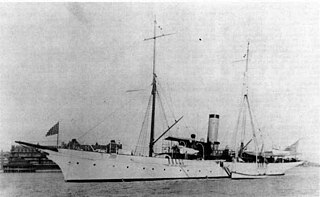
USS Yankton was a steel-hulled schooner built in 1893 at Leith, Scotland, by Ramage & Ferguson. She was acquired by the US Navy in May 1898; renamed Yankton; and commissioned on 16 May 1898 at Norfolk, Virginia.

A steam yacht is a class of luxury or commercial yacht with primary or secondary steam propulsion in addition to the sails usually carried by yachts.
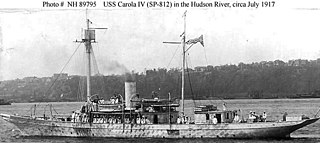
USS Carola IV, was a patrol ship of the United States Navy, built in 1885 by Culzean Shipbuilding & Engineering Company, Maidens, South Ayrshire, Scotland, as the steam yacht Black Pearl. She was built for the Earl of Pembroke & Montgomery. In 1895 the yacht was sold to E B Sheldon of Chicago, Illinois, USA. and in 1900 she was purchased by Evans R Dick of Philadelphia, Pennsylvania and renamed Elsa. She was later briefly named Haida and Columbine, but by mid-1910 was owned by Leonard Richards of New York City, Commodore of the Larchmont Yacht Club.
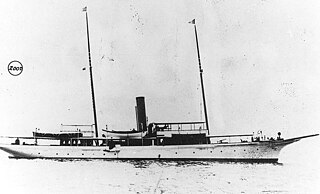
USS Christabel (SP-162) was a civilian steam yacht that was built in Glasgow in 1893 for a Scottish industrialist. She had an American owner by 1910, served as a United States Navy patrol ship in the latter part of the First World War, and afterward was returned to US civilian service.

USS Corona (SP-813) was a yacht acquired by the U.S. Navy during World War I. She was outfitted as a patrol craft, and assigned to the North Atlantic Ocean, based out of Brest, France, to protect shipping from the German submarines and Q-ships. Post-war she was decommissioned, returned to her original condition, and disposed of by public auction.

USS Wakiva II (SP-160), often referred to as USS Wakiva, was an armed yacht that served in the United States Navy from 1917 to 1918 and saw combat in World War I. She was originally the yacht SS Wakiva II built for Lamon V. Harkness in Scotland.

USS Zara (SP-133) was a steam yacht that was built in Scotland in 1890, passed through a number of British, Canadian and US owners, and ended up as a passenger steamship in Greece after the First World War. She was renamed several times, becoming Solgar, Electra and finally Zoodohos Pigi. In the latter part of the war she spent a year as an armed yacht in the United States Navy.

The third USS Wanderer (SP-132), was an armed yacht that served in the United States Navy from 1917 to 1919.
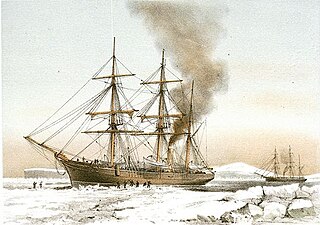
HMS Discovery was a wood-hulled screw expedition ship, and later storeship, formerly the sealing ship Bloodhound built in 1873 in Dundee. She was purchased in 1874 for the British Arctic Expedition of 1875–1876 and later served as a store ship. Discovery was sold in 1902, reverting to the name Bloodhound and her previous sealing trade. The ship was wrecked in Newfoundland in 1917.

USS Owera (SP-167), was an armed yacht that served in the United States Navy as a patrol vessel from 1917 to 1919. The vessel, under the name O-We-Ra, was built as a steam yacht in Leith, Scotland in 1907 for Frederick H. Stevens of Buffalo, New York. In 1915 the yacht was sold to United States Senator Peter G. Gerry of Rhode Island and registered in Providence, Rhode Island as Owera.

Adele was a steel screw steamer that was built in 1906 as a yacht. She was twice commissioned into the Royal Australian Navy (RAN), firstly as HMAS Franklin and later as HMAS Adele. She was wrecked at Port Kembla, New South Wales on 7 May 1943.

USS Surf (SP-518) was a steam yacht that was offered to the United States Navy in 1917 but was never accepted.
SY Liberty was a steam yacht built in 1908 at Leith, Scotland, for Joseph Pulitzer and one of the largest private yachts of its day. She served as a Royal Navy hospital ship during World War I.

White Ladye was a steam yacht built in 1891 by Ramage & Ferguson of Leith from a design by W C Storey. She had 3 masts; length 204 ft; breadth 27 ft; 142 hp steam powered. She was built for Francis Edward Baring and named White Ladye.
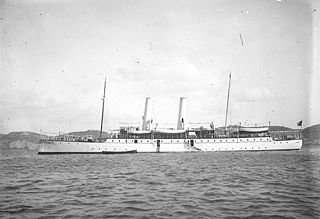
Amélia IV was a passenger ship built in 1900 as SS Banshee. As Amélia IV, she served as the Royal yacht for the Portuguese monarch from 1901 to 1910. From 1910 to 1937 she served the Portuguese Navy as an auxiliary ship under the name Cinco de Outubro.

Ramage & Ferguson was a Scottish shipbuilder active from 1877 to 1934, who specialised in luxury steam-yachts usually with steel hulls and timber decks. They also made several notable windjammers including the stunning five-masted København.

Gunilda was a steel-hulled Scottish-built steam yacht in service between her construction in 1897 and her sinking in Lake Superior in 1911. Built in 1897 in Leith, Scotland by Ramage & Ferguson for J. M. or A. R. & J. M. Sladen, and became owned by F. W. Sykes in 1898; her first and second owners were all from England. In 1901, Gunilda was chartered by a member of the New York Yacht Club, sailing across the Atlantic Ocean with a complement of 25 crewmen. In 1903, she was purchased by oil baron William L. Harkness of Cleveland, Ohio, a member of the New York Yacht Club; she ended up becoming the club's flagship. Under Harkness' ownership, Gunilda visited many parts of the world, including the Caribbean, and beginning in 1910, the Great Lakes.


















